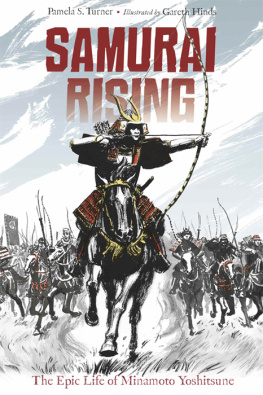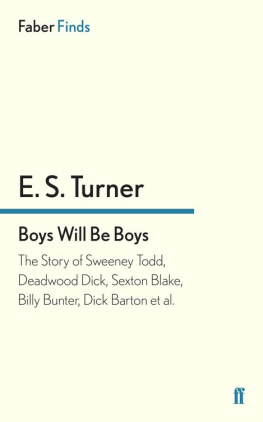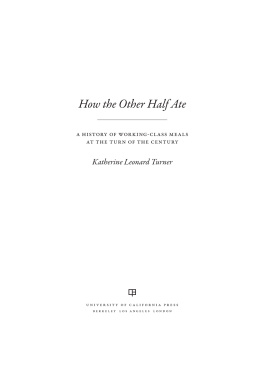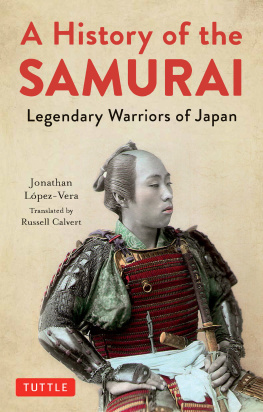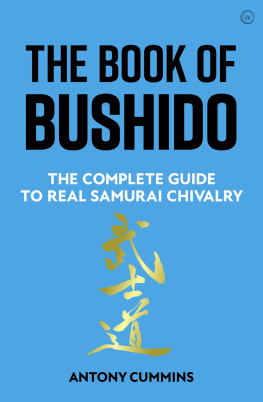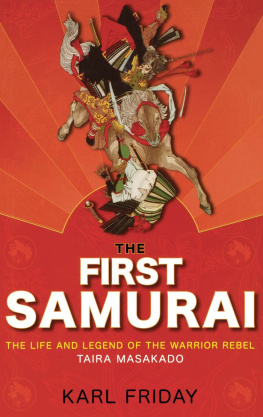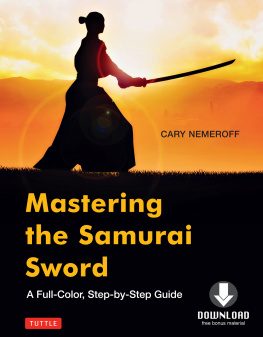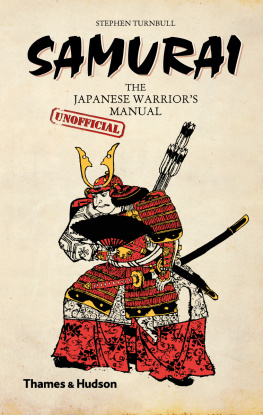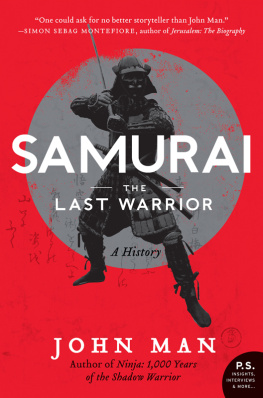Index
Antoku
death of,
ghost of,
kidnapping of,
named crown prince and emperor,
archery,
handedness and,
types of arrowheads,
armor,
Atsumori, see
Azuma kagami,
barbarians,
barrier stations (checkpoints),
Bash, see
Benkei,
death of,
Bishamon-ten,
Biwa, Lake,
Buddhism,
temples and,
China,
influences on Japanese culture,
writing,
Dan-no-Ura,
today,
dance,
dysentery,
Fuji River, battle of,
Fujiwara Hidehira,
death of,
remains of,
Fujiwara Tadahira,
Fujiwara Yasuhira,
remains of,
Genghis Khan,
go (game),
Go-Shirakawa (Retired Emperor),
alliance with Kiso,
death of,
friendship with Yoshitsune,
grandsons of,
kidnappings of,
power of,
power struggle with Yoritomo,
sons of,
Go-Toba,
grappling hooks,
Hachiman,
haiku (poetic form),
Hall of Gold,
today,
Hidehira, see
Hiraizumi,
destruction of,
hunting in,
today,
Yoshitsunes lifestyle in,
Hiyodorigoe Cliffs,
Hj Masako (Yoritomos wife),
Hj Tokimasa (Yoritomos father-in-law),
Hj Yoshitoki (Yoritomos brother-in-law),
Hokkaido,
Honshu,
hunting,
Ichi-no-Tani,
today,
Ikezuki (horse),
Ikuta-no-Mori,
imperial regalia,
Inland Sea,
Iris Festival,
Ise Sabur,
death of,
Kagetoki,
hatred of Yoshitsune,
letter written by,
murder of,
sons of,
Kakuichi,
Kamakura,
growth and prosperity of,
shrines and temples in,
today,
Kamo River,
kanji (Chinese characters),
Kannon,
katana (sword),
Katsu-Ura,
armor of,
death of,
Kiyomori, see
Koromo River,
Koshigoe,
kumade (clawed weapon),
Kurama Temple,
today,
Yoshitsunes lifestyle at,
Kyoto,
defense of,
earthquake in,
gates of,
hunger and disease in,
life in,
Lord Kisos control of,
prison in,
today,
Yoritomos return to,
Yoshitsune and Noriyoris assault on,
Yoshitsunes lifestyle in,
Kyushu,
literature, Japanese,
Lord Kiso, see
Lord of Kamakura, see
Matsuo Bash,
measles,
Midnight strike,
Minamoto Noriyori (Yoshitsunes half brother),
arrival in Kamakura of,
battle of Dan-no-Ura,
death of,
incompetence of,
provincial governor,
siege of Ikuta-no-Mori,
status of,
Minamoto Sanetomo (Yoritomos son),
Minamoto Tametomo (Yoshitsunes uncle),
death of,
exile of,
Minamoto Yoriie (Yoritomos son),
Minamoto Yorimasa,
armor of,
battle for Hiraizumi,
death of,
defender of the emperor,
exile of,
father-in-law of,
grandson of,
intelligence of,
manhunt for Yoshitsune,
meeting with Yoshitsune,
most powerful samurai in Japan,
rivalry with Yoshitsune,
shogun,
sons of,
wife of, see
Minamoto Yoshiie (Yoshitsunes great-grandfather),
Minamoto Yoshitomo (Yoshitsunes father),
Minamoto Yoshitsune
alliance with Yukiie,
armor of,
assassination attempt,
battle of Dan-no-Ura,
battle of Ichi-no-Tani,
battle of Uji River,
battle of Yashima,
childhood of,
children of,
commander of Hiraizumi warriors,
companions of,
courage of,
death of,
exile and hiding of,
father of, see
father-in-law of,
fosterage at Hiraizumi,
friendship with Go-Shirakawa,
ghost of,
illness and depression of,
inexperience of,
junior lieutenant rank,
leadership style of,
legacy of,
letter written by,
literary depictions of,
manhunt for,
mother of, see
physical appearance of,
pride and ego of,
relationship with Shizuka,
religious training of,
remaining artifacts of,
rivalry with Noriyori,
rivalry with Yoritomo,
rumors of death of,
weapons of,
wives of,
Yoritomos deputy in Kyoto,
Minamoto Yukiie (Yoshitsunes uncle),
death of,
Mochihito,
death of,
mono no aware (awareness of fleeting beauty),
Munemori, see
Murasaki Shikibu,
naginata (spear),
Nara temple,
Noritsune, see
Noriyori, see
Phoenix Hall,
today,
Pillow Book,
pirates,
poetry,
puppetry,
rakes,
Rashmon,
Retired Emperor, see
Rokuj,
today,
sake (rice wine),
samurai; see also
ethics of,
fighting tactics of,
job security and,
most powerful in Japan,
rank and,
rule of Japan,
status of,
training of,
women,
Sanetomo, see
Sea of Japan,
Sei Shnagon,
seppuku (ritual suicide),
Seta Bridge,
Settsu coast,
Shikoku,
Shintoism,
shirabyshi (dancers),
Shizuka,
bravery of,
death of,
pregnancy of,
shogun (military leader of Japan),
Shshun, see
smallpox,
spears,
sun goddess,
swords,
structure of,
tachi (sword),
Tadahira, see
Tadanobu,
death of,
Taira Atsumori,
Taira Kiyomori,
armor of,
brothers of,
daughter of,
death of,
grandsons of,
most powerful samurai in Japan,
nephews of,
sons of,
spirit of,
wife of,
Taira Munemori,
death of,
son of,
Taira Noritsune,
death of,
Tale of the Genji, The,
Tale of the Heike, The,
Tametomo, see
Tayguro (horse),
teeth, blackening of,
Togashi,
Tokiwa (Yoshitsunes mother),
beauty of,
Tosab Shshun,
Tsuginobu,
death of,
Uji Bridge,
Uji River,
battle of,
today,
Vermillion Sparrow Gate,
warhorses,
loyalty of,
warrior-monks,
Washinoo,
death of,
women
aristocrats,
dancers, see
divers,
entertainers at inns,
status of,
yamabushi (wandering monks),
Yashima,
today,
Yasuhira, see
Yoriie, see
Yorimasa, see
Yoritomo, see
Yoshiie, see
Yoshinaka, see
Yoshino Mountains,
Yoshitomo, see
Yoshitsune, see
Yukiie, see
Yukinaga,


For Connor Townsend and my friends at Berkeley Kendo Dojo and Oakland Kendo DojoP. S. T.
For Sara Norton and Jim Kelso, who helped a nerdy, headstrong boy explore Japanese culture; and to Bill Gleason Sensei, who brought me back to aikidoG. H.
Text copyright 2016 by Pamela S. Turner
Illustrations copyright 2016 by Gareth Hinds
Page 27: This forgotten tree turns to sorrow: From The Tale of the Heike, translated by Royall Tyler, translation copyright 2012 by Royall Tyler. Used by permission of Viking Books, an imprint of Penguin Publishing Group, a division of Penguin Random House LLC.
Page 163: A dream of warriors summer grasses: Classical Japanese Prose: An Anthology compiled and edited by Helen Craig McCullough, copyright 1990 by the Board of Trustees of the Leland Stanford Jr. University. All rights reserved. Used with the permission of Stanford University Press, www.sup.org.

